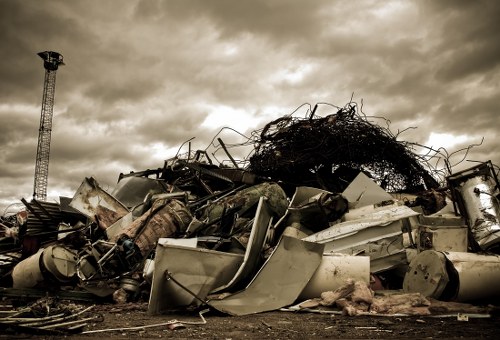Construction Waste Clearance in Temples: Ensuring Sanctity and Sustainability
Understanding Construction Waste in Temples

In the serene environment of temples, construction activities are often undertaken to expand or renovate facilities. However, these activities generate a significant amount of construction waste, which, if not managed properly, can disrupt the sanctity and functionality of these sacred spaces.
Construction waste includes a variety of materials such as concrete, wood, metals, and plastics. The proper clearance of these materials is crucial to maintain the temple's aesthetic and environmental integrity.
Moreover, improper disposal of construction waste can lead to environmental degradation, posing health risks to the community and harming the surrounding ecosystem.
Types of Construction Waste Generated

Demolition Debris
During demolition, various debris like bricks, tiles, and mortar are produced. These materials need to be carefully segregated to facilitate recycling and proper disposal.
Recyclable Materials
Materials such as metals, glass, and certain plastics can be recycled, reducing the overall environmental footprint of the construction project.
Hazardous Waste
Certain construction projects may generate hazardous waste, including asbestos or lead-based paints, which require specialized handling and disposal methods.
Importance of Proper Waste Clearance in Temples

Preserving Sacred Spaces
Temples are not just places of worship but also cultural heritage sites. Proper waste clearance ensures that these spaces remain clean, safe, and inviting for devotees.
Environmental Impact
Effective waste management minimizes the adverse effects on the environment, promoting sustainability and protecting local biodiversity.
Compliance with Regulations
Adhering to local and national waste disposal regulations is essential to avoid legal repercussions and ensure responsible construction practices.
Methods for Effective Construction Waste Clearance

Segregation and Recycling
Segregating waste at the source allows for more efficient recycling and reduces the volume of waste that needs to be disposed of in landfills.
Waste Disposal Techniques
Employing advanced waste disposal techniques, such as compacting and incineration, can significantly lower the environmental impact of construction activities.
On-site Management
Implementing on-site waste management systems ensures that waste is handled promptly and efficiently, preventing accumulation and potential hazards.
Choosing the Right Waste Clearance Service

Key Considerations
Selecting a reliable waste clearance service involves evaluating their experience, expertise, and adherence to environmental standards.
Professional Expertise
A professional service will have the necessary equipment and trained personnel to handle various types of construction waste safely and effectively.
Cost-Effectiveness
While competitive pricing is important, it should not compromise the quality of waste management services provided.
Benefits of Professional Construction Waste Clearance

Time and Cost Efficiency
Professional services streamline the waste clearance process, saving time and reducing overall project costs by preventing delays and minimizing waste disposal expenses.
Compliance with Regulations
Ensuring that waste management practices comply with all relevant laws and guidelines protects the temple from potential legal issues and promotes responsible stewardship.
Enhanced Sustainability
By utilizing eco-friendly waste clearance methods, professional services contribute to the long-term sustainability of temple surroundings and the broader community.
Conclusion
Effective construction waste clearance in temples is essential for maintaining the sanctity, safety, and sustainability of these revered spaces. By partnering with professional waste management services, temple administrations can ensure that construction projects proceed smoothly while minimizing environmental impact.
Contact us today to learn more about our specialized construction waste clearance services designed to meet the unique needs of temples.